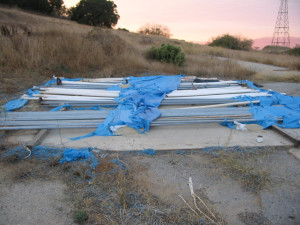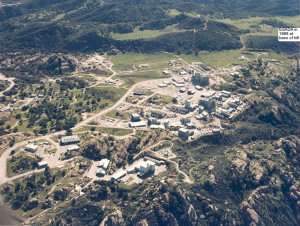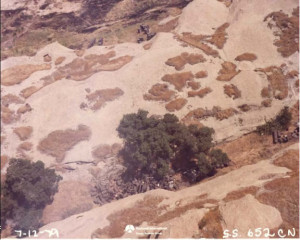Rocketdyne’s earthquake rift transports toxins down into Runkle Canyon

EnviroReporter.com – October 20, 2009
The mystery of Runkle Canyon Creek’s heavy metal soil and water contamination may be simple to a fault – the Burro Flats Fault to be exact. The earthquake rift runs the length of the former Rocketdyne lab, east to west, and dips into Runkle Canyon and turns north into the city of Simi Valley.
The Burro Flats Fault which sculpted this beautiful land of vernal pools and soaring cliffs may also be the main path that pollutants have found their way down into Runkle Canyon where a citizens group called the Radiation Rangers discovered arsenic, nickel, vanadium and other poisonous metals in the creek water and soil in 2007. The results were subsequently verified by city sampling and tests.
EnviroReporter.com has uncovered evidence that suggests that a Cold War era facility at the neighboring Santa Susana Field Laboratory (SSFL), and an adjacent chemical dump, could be the source of Runkle Canyon creek’s heavy metal pollution. Thousands of pages of documents about the site, located in the former nuclear research “Area IV” of the 2,850-acre lab and which sits on top of the Burro Flats Fault, reveal extensive contamination.
Recent studies at the proposed nuclear repository at Yucca Mountain, Nevada and at the Department of Energy-funded Lawrence Livermore National Laboratory have shown that contaminants readily flow down and through earthquake faults. In 2005, the late former state geologist under Governor Reagan, Jim Slosson, confirmed to EnviroReporter.com that the faults in this specific area of the lab were transporting groundwater goo offsite.
The Empire State Atomic Development Authority, or ESADA, sat in the westernmost corner of Area IV of Boeing’s lab on 1.5 acres. The dismantled site is undergoing a costly remediation for a host of toxic waste including arsenic, vanadium, boron, glycol ethers and Dowanol-PM that was used to clean piping and components at the infamous Sodium Reactor Experiment or SRE.
Hundreds of leaking barrels of chemicals have been removed from the unsecured site near an open gate leading to Runkle Canyon. Piping covered by ripped tarps litters the deserted foundations of the ESADA, perhaps the same pipes used to blow apart testing tolerances for use in the SRE.
Late last year, hardware from the contaminated facility was also found outside of the lab perimeter (Image 0036) by EnviroReporter.com in the highlands above Runkle Canyon. Offsite dumping like this, along with the discovery of the contamination connection along the fault line, doesn’t surprise one of Radiation Rangers.
“We’ve always figured that this stuff was coming down the hill from Rocketdyne,” says the Reverend John Southwick. “But now we know from where and how it got here. That’s astonishing. But I’m not surprised that no one has put goo and goo together considering Boeing doesn’t want to be on the hook for any contaminants on KB Home property and KB is determined to develop downhill from a place that had meltdowns.”
There were ten nuclear reactors in Area IV. Six had major accidents including the Sodium Reactor Experiment which melted down in 1959 spewing, by some estimates, hundreds of times more radiation from the uncontained reactor building than the more infamous Three Mile Island meltdown did twenty years later.
The lasting effects of radiological and chemical contamination at Area IV, and the surrounding communities, are still present today and this section of SSFL is undergoing a characterization and cleanup that will cost hundreds of millions and take until at least 2017. Huge fines have been assessed the company that now owns the site, Boeing, for contaminated offsite discharges into the headwaters of the Los Angeles River, where most of Area IV drains to as well.
The Department of Energy, or DOE, which is responsible for the cleanup of the 90-acre Energy Technology Engineering Center (ETEC) in Area IV, estimates that the final cost of remediating ETEC will be between $167.9 million to $221.4 million.
Southwick is concerned that the current Runkle Canyon “draft Response Plan” currently proposed by developer KB Home to clean up the 1,595-acre property, has nothing in it about this possible source of chemicals coming down the creek. The plan is a result of an agreement last year between KB Home and the Department of Toxic Substances Control (DTSC), which is in charge of investigating the canyon’s environmental conditions largely in reaction to public uproar over Runkle Canyon revelations of heightened strontium-90 readings in site soil. In August, the department replaced its Project Manager for the Runkle Canyon and Rocketdyne cleanups, Norman E. Riley, and pledged to toughen up its oversight.
The current plan includes no retesting of the creek and determining the source of the pollution which was found in even greater amounts by the city of Simi Valley a month after the Ranger’s findings made headlines. The Rangers, who maintain a website called StopRunkledyne.com, say that this new information about the ESADA’s contamination making its way down the Burro Flats Fault raises their concerns even more about possible development of Runkle Canyon.
“This new DTSC team couldn’t have come at a better time because they seem serious about making sure Runkle Canyon is safe for all the people that will go up there hiking and biking around thinking it’s okay,” Southwick says. “That whole area has to be tested for these toxins because it’s unsafe for humans and pets especially when the water’s flowing. And we’ve got to figure out how to turn off Rocketdyne’s toxic tap, as it were, because that water is coming down through Runkle Canyon to the Arroyo Simi and getting in the groundwater many of us drink.”
Southwick is hoping that discovery of a contamination connection between the lab and the canyon may persuade government officials to order the developer to complete a much more extensive toxic evaluation of the property before it is developed. KB Home has envisioned this part of its property as “open space” which would be accessible by new residents and the public. Southwick just hopes it isn’t too open.
“The more we learn about Runkle Canyon’s problems, which are now the city of Simi Valley’s problems because they annexed the place in 2006, the more we need to reconsider the idea of letting people up Runkle willy-nilly if and when it ever opens,” says Southwick. “The amount of toxins in the water could harm your pets, that’s for sure, and there should at least be signs saying ‘don’t touch the water’ and ‘visit this place at your own risk.’”
Empire State Atomic Development Authority
The ESADA sits atop the predominant earthquake rift running east to west at the sprawling former Rocketdyne facility. Heavy metal found in Runkle Canyon’s creek water and soil at high levels, including arsenic, vanadium and sodium, are also found at the 1.5 acre ESADA site but in much higher concentrations.
Not all facilities in the 270-acre Area IV of the SSFL were part of ETEC, which had ten reactors, a “hot lab” where nuclear power plant fuel rods from around the country were shipped after use in order to be cut apart, and a sodium burn pit, an unlined area filled with goo where barrels of radioactive sodium were tossed in and then set ablaze by workers choosing lots and firing a rifle at the canisters.
ESADA was one of those facilities outside of ETEC and the site closest to the headlands of Runkle Canyon which the lab has an 11-acre drainage down into KB Home property. The ESADA site was first operated by Atomics International, a division of North American Aviation, and later of Rockwell International which was bought by the Boeing Company in 1996.
Much of Rockwell International, along with Rocketdyne, was sold to Boeing in 1996 where it served as part of Boeing Integrated Defense Systems until its sale to Pratt & Whitney on August 2, 2005. That Pratt & Whitney purchase included all of Rocketdyne except the Santa Susana Field Laboratory land itself.
Five ESADA chemical use areas being evaluated for contamination include the former storage yard for the barrels of chemicals, former Process Development Unit, Aboveground Storage Tank, pistol range and the Sodium Test Area.
According to a 1964 Rockwell report, “Sodium-water tests were conducted at the Building 814 test structure. Building 814 was a large leak injector device (LLID), where heated sodium, high-pressure water, and steam flowed via tubes and piping to a test section to simulate tube failure in a sodium graphite reactor (SGR). To initiate the tests, discs that blocked the high-pressure water and steam lines from the test section were mechanically ruptured.”
Underground piping connected B814 to a concrete-lined pool just north of B886 at the intensely polluted Sodium Burn Pit. It is possible that the Burro Flats Fault helped transport leaked sodium down into Runkle Canyon which tests extremely high for the salt.
The ESADA concrete pool was utilized for cleaning alkali bearing components. In the late 1960s, the ESADA area was also used for drum storage and surrogate fuel pellet testing. It was called the ESADA Chemical Storage Yard and was used for the storage of more than 500 drums containing Dowanol-TM glycol ethers and ethanol, and an unspecified number of empty drums. Approximately 120 drums contained Dowanol-PM (propylene glycol methyl ether), which was nearly saturated with sodium.
The Dowanol-PM was used to clean piping and components at the Sodium Reactor Experiment. Over 400 of the drums contained denatured ethanol. The ethanol drums had varying concentrations of sodium, and some of them were known to have leaked.












Aaah, the money issue. Spot on Constance!
Environmental felons like Boeing need to do the right thing and buy out the Runkle developer, clean that land up to SB990 standards, then convert it to open space once cleaned to SB990 standards.
If one checks out Boeing’s income statement, they will find the polluter has enough greenbacks to handle KB with ease. All corporations have insurance companies, maybe EnviroReporter can obtain the insurance policies?
In fact, the polluter has more than enough to also buy out poisoned Woosley-Dayton where there are similar problems.
Being that Boeing is a contractor of the federal government may have some bearing on who they hide behind when push comes to shove. The buck might be passed back to DOE, NASA, the Defense Department, and etcetera. It might be a good idea to consult with attorneys from NRDC, CBG, and so forth.
IANAL, but couldn’t KB Home sue Boeing for the pollution? I don’t think Boeing has any special protection – SSFL is not a Superfund site, right? Assuming KB Home never gets to develop, they’re going to want to recover their investment somehow.
Unless Boeing simply buys them out to avoid the lawsuit.
Michael,
I’m very surprised to see you didn’t mention Tom Seckington or interview him for this piece. Without him weighing in, this report has much less credibility. For those who don’t know, he’s the DTSC Hydro-geologist who’s been studying groundwater movement at SSFL for (I think) 17 years. I’ve been working and consulting with him for the last 3 years and I find him to be the acknowledged expert on SSFL groundwater as well as one of the most honest people working on this project. He’s been totally dedicated to helping our community.
Perhaps you could do a follow up on this report after you talk to him.
Nice work, Mr. C.
I am frankly alarmed that there is a newish citizens group on the other side of the pass from the wonderful rangers that takes in ‘donations’ from the environmental felon mentioned above in the second comment above. This is something it is hoped will not impact the clean-up effort, but this writer feels otherwise. Do you think you can possibly check out the ‘donation’ history and find out more regarding the frequency and amount of polluter’s contributions? It sure sounds like dirty money is on its way to usurp the Hill’s detox marathon that we know is still in its infantile stages at the moment.
Btw, your good work does not go unnoticed.
The Radiation Rangers rock! Indeed, it would be a grand day if and when Runkle follows the example of Ahmanson and is never allowed to be used for residential space, NEVER EVER. Hats off to Mary Weisbrock who sets the bar high for Hawkeye, Toxic Terry, Good Rev John, and the rest of the crew with Mary’s (and her group, Save Open Space) previous involvement in the saving of Ahmanson Ranch. It looks like Runkle is on the same path (fingers crossed). We are very fortunate to have these wonderful people by the community’s side.
Hopefully, the derisiveness of recent noted in the article above, will come to an end. It’s just plain silly to let the badgering fester on, even though the article’s author is 100% in the right. Hypocrisy has a definition and it is this: “having desirable or publicly approved attitudes, beliefs, principles, etc., that one does not actually possess” — the email exchange with DTSC as mentioned is but one erratic example of many; some of which will most likely be uncovered as time goes by, having known the antics of said local perpetrator. . .
Advice: please focus on your marvelous investigations and don’t stop! You guys are just too valuable to let little things get in your way. The community can see through the pettiness, the fraud, the abuse, the indecency, the injustice. We have your back and we scorn the backstabbers out there be it an errant regulator, a mal-adjusted activist, or an ignorant neighbor. Keep on keeping on!
Michael,
This is truly an amazing piece of investigation that you have done. It seems as if you are now extending your terrific reporting skills into becoming a discovery making geologist. Would that you could also do a similar scientific reporting exploration of the whole SSFL—all 2850 acres. Dream on!
From everything I have been able to read or hear discussed, it certainly seems to me that these underground acquifers and earthquake faults could absolutely be the source of our most scary, on-going and long term contamination nightmares. And, they are frequently described as being “poorly understood”. By comparison,soil sampling and removing dangerous surface contamination may turn out to be child’s play.
I certainly hope that you will keep up your good work in Runkle Canyon, and that you will continue to keep the KB builders paralyzed. So far, you and the Radiation Rangers have been more successful at doing this than even the recession.
When you have some free time, I hope that you will come over to Chatworth Park-South, which is just a few blocks away from where I and over 750 Rockpointe condo owners live. We have an underground water situation here involving the longest 7,000 ft.train tunnel (#26) in the USA,located at the North end of our beautiful Chatsworth Park S. The trains go from the Chatsworth station to Simi Valley.
This train tunnel happens to be located at the Southern end of the Chatsworth geological formation…which, I believe, originates up on the SSFL. We have 4300 gallons of underground water flowing, DAILY, through sump pumps in the tunnel, and being ultimately dumped into Chatsworth Park S., which is slowly being turned into a wetland.
The original Railroad builders ran into this water problem in about 1898, when they were constructing the railroad tracks. That’s how long this problems has been going on. Although the tracks have since been raised, the tunnel still gets flooded during the rainy season.
The Water Quality Board has been contacted, has visited the tunnel, and, they in turn have ordered the Railroad to obtain an NPDS permit to “de-water”. This permit process is pending, and we are all very concerned about radionuclides or toxic contaminants that could possibly be in this water…since it could very likely be flowing down underground all the way from down the Chatsworth Formation,from the SSFL. The railroad is apparently required to do some water testing before they can be granted a permit.
In the meantime, the Rangers and other residents should give you an ACADEMY AWARD.